Abstract
An analysis of the known cytotoxic and helper T cell epitopes has revealed similarity within their primary sequences. These similar motifs, characteristic of the known determinants, have been incorporated into predictive templates that have been used successfully to define eight helper and three cytotoxic epitopes in four different proteins. When the defined epitopes are segregated by restriction element, allele specific subpatterns emerge centering around the general pattern. The presence of similarities argues that the binding of peptide antigens to class I and class II is similar in nature. In addition, these motifs can be used to predict accurately areas within proteins capable of being recognized by individual MHC class I and class II molecules.
Full text
PDF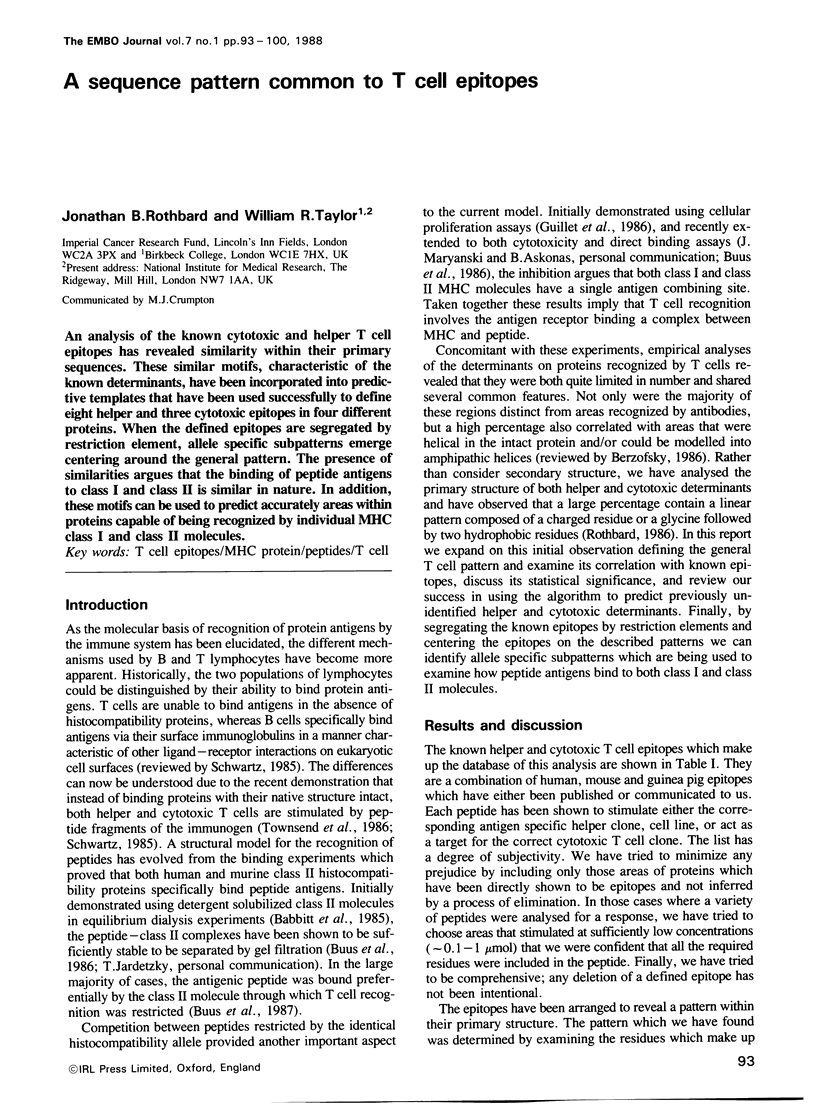

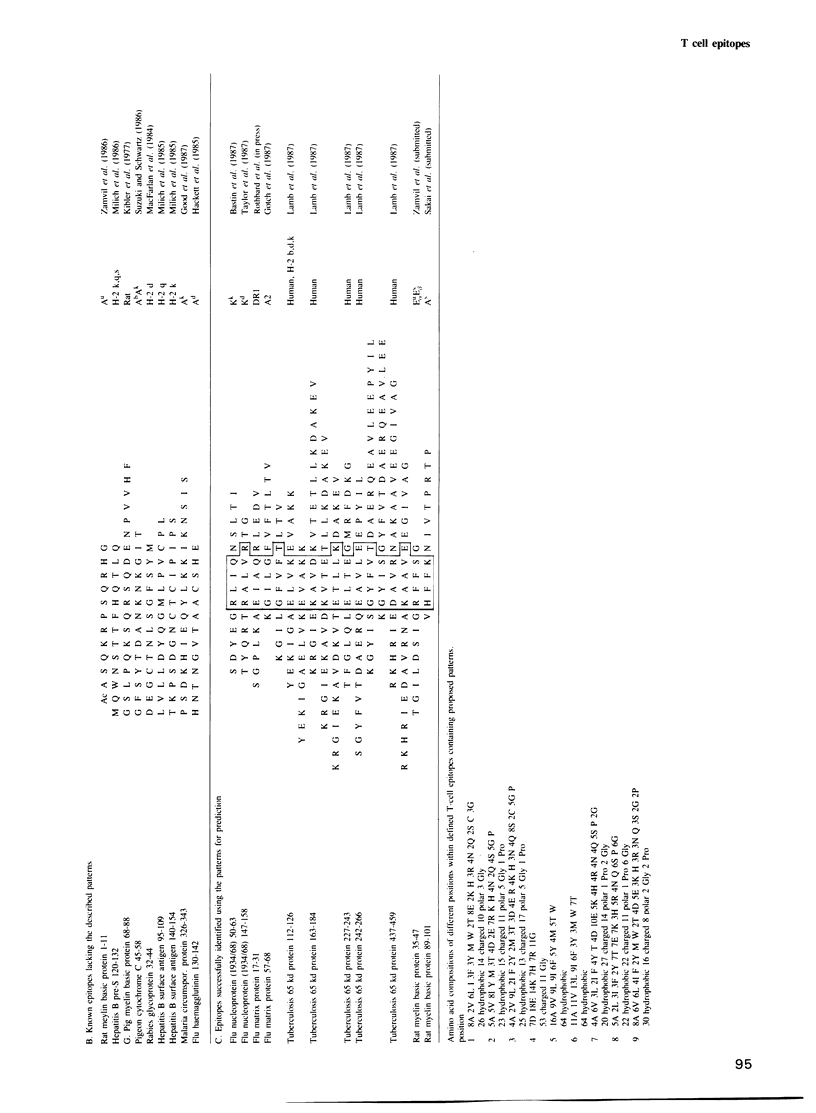
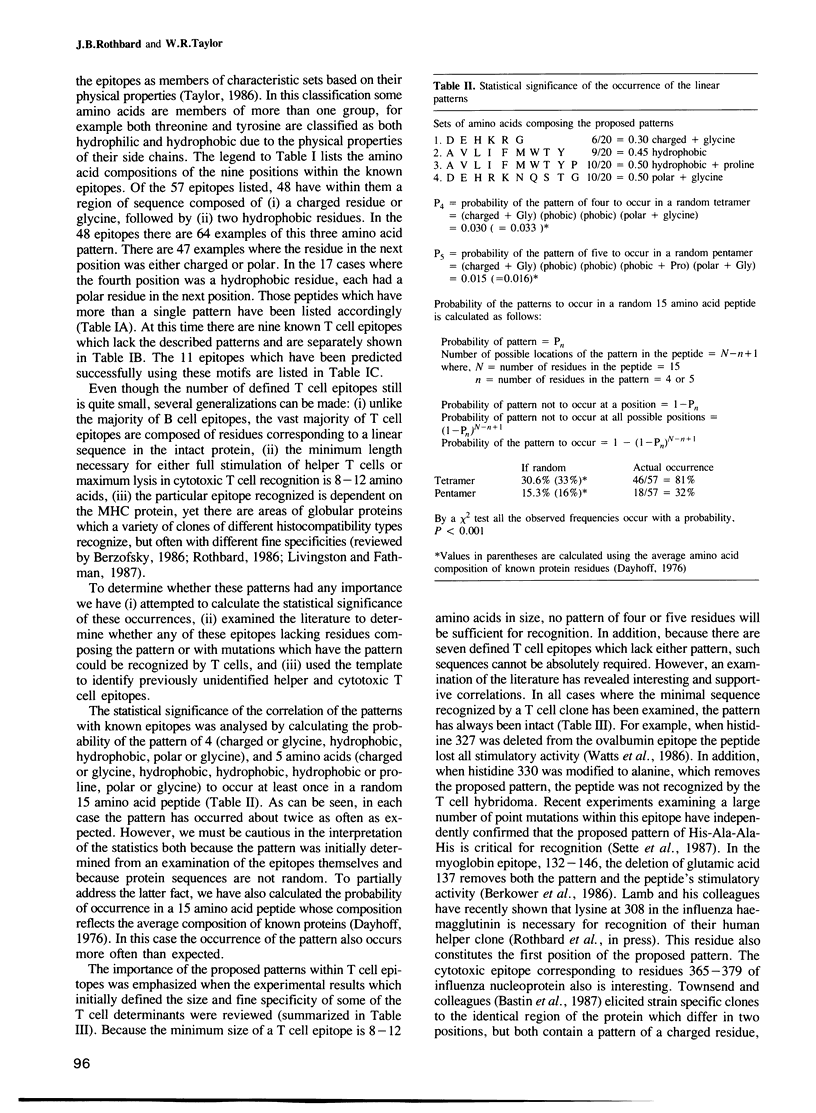
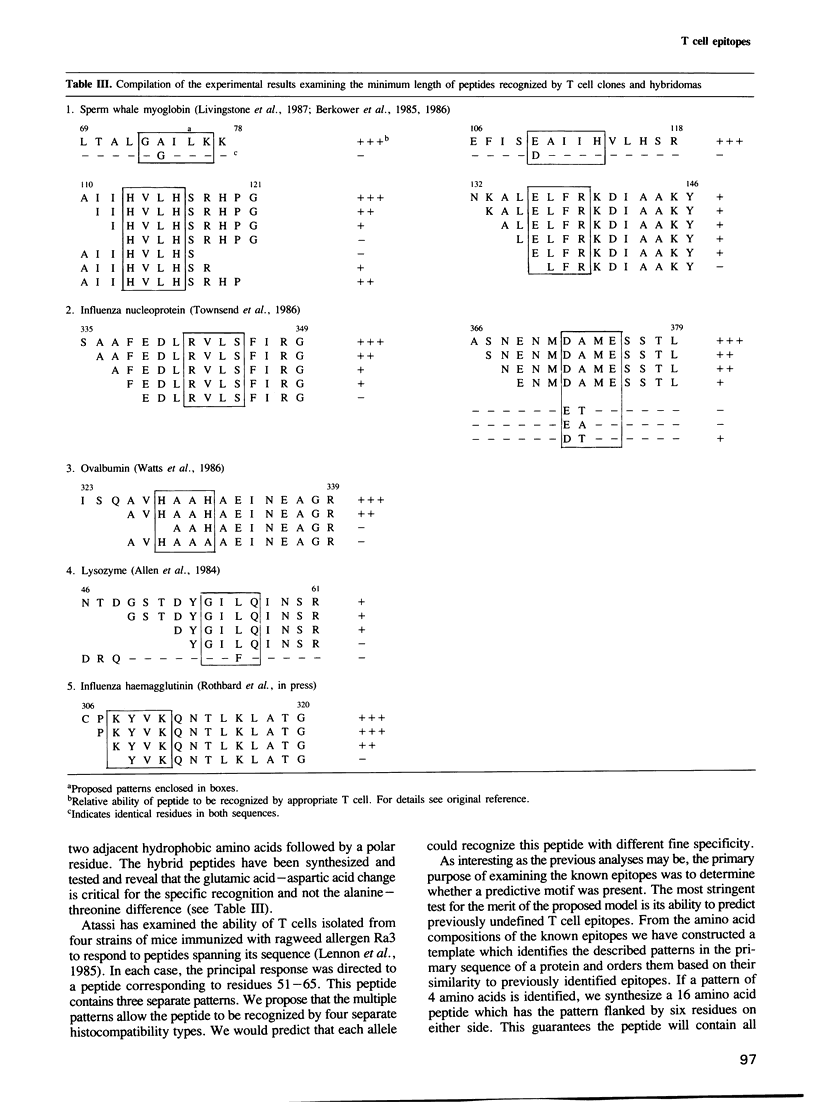
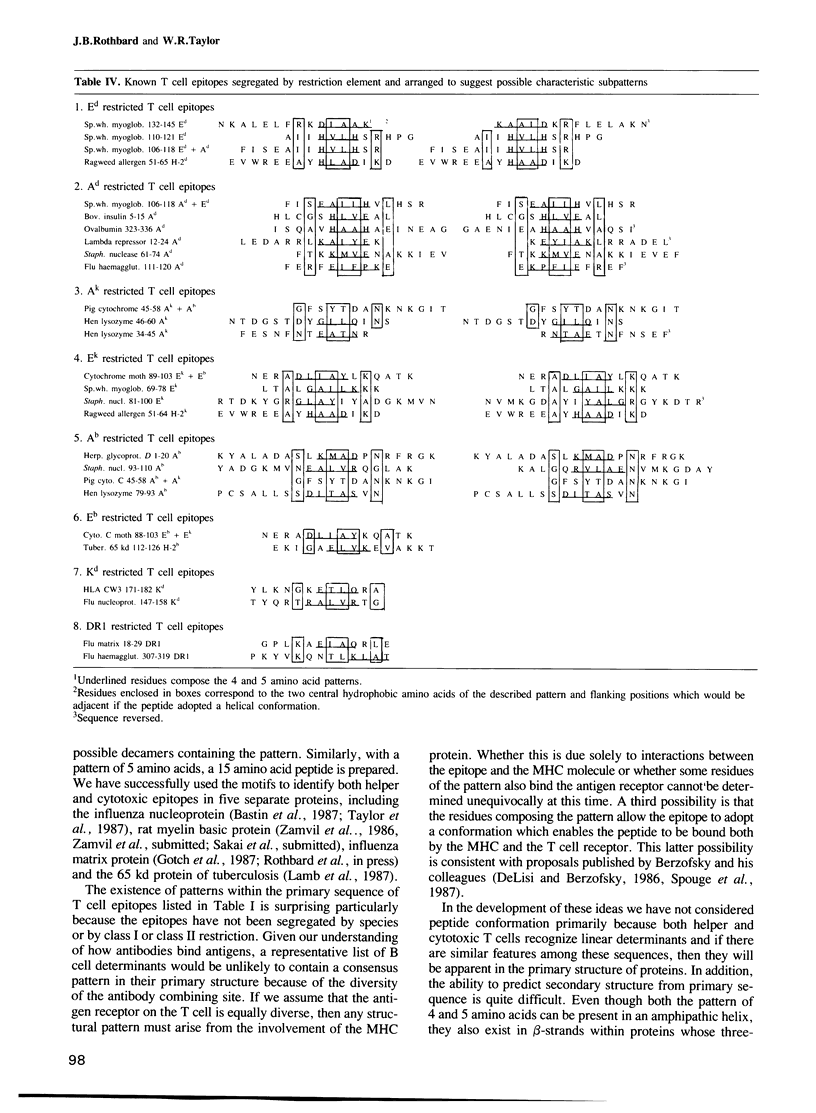
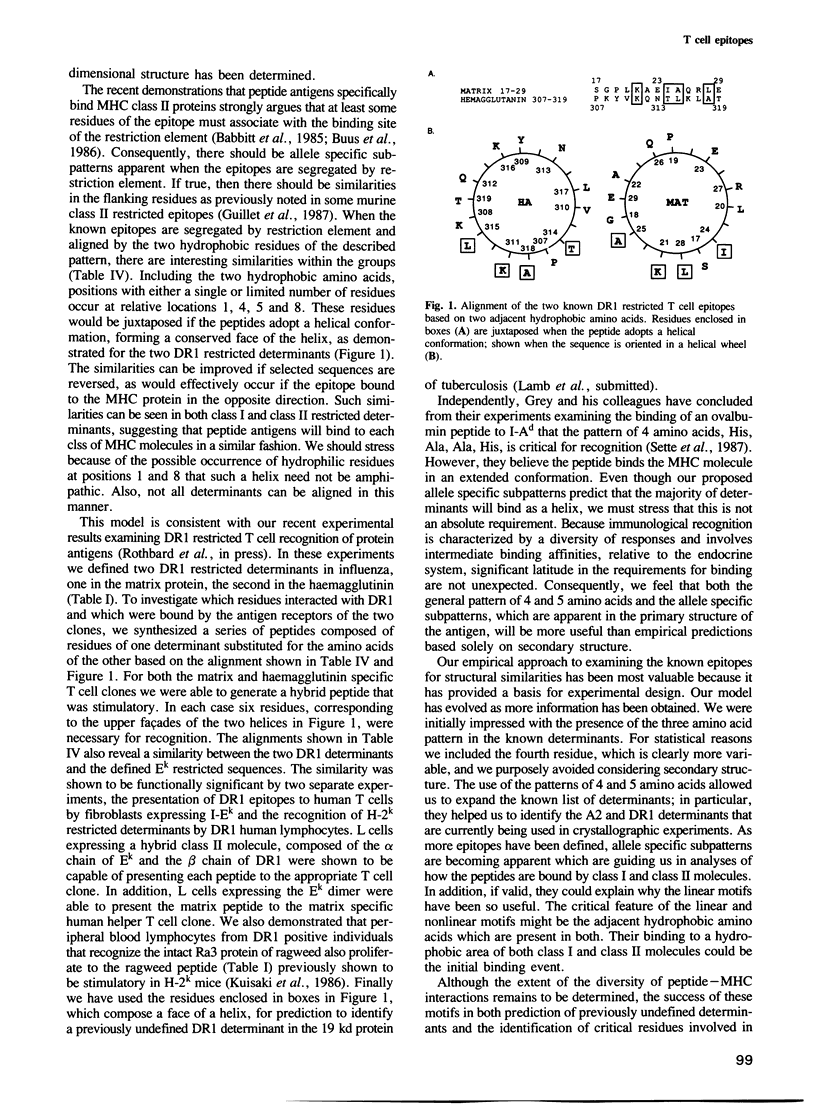

Selected References
These references are in PubMed. This may not be the complete list of references from this article.
- Allen P. M., Strydom D. J., Unanue E. R. Processing of lysozyme by macrophages: identification of the determinant recognized by two T-cell hybridomas. Proc Natl Acad Sci U S A. 1984 Apr;81(8):2489–2493. doi: 10.1073/pnas.81.8.2489. [DOI] [PMC free article] [PubMed] [Google Scholar]
- Babbitt B. P., Allen P. M., Matsueda G., Haber E., Unanue E. R. Binding of immunogenic peptides to Ia histocompatibility molecules. 1985 Sep 26-Oct 2Nature. 317(6035):359–361. doi: 10.1038/317359a0. [DOI] [PubMed] [Google Scholar]
- Babbitt B. P., Matsueda G., Haber E., Unanue E. R., Allen P. M. Antigenic competition at the level of peptide-Ia binding. Proc Natl Acad Sci U S A. 1986 Jun;83(12):4509–4513. doi: 10.1073/pnas.83.12.4509. [DOI] [PMC free article] [PubMed] [Google Scholar]
- Bastin J., Rothbard J., Davey J., Jones I., Townsend A. Use of synthetic peptides of influenza nucleoprotein to define epitopes recognized by class I-restricted cytotoxic T lymphocytes. J Exp Med. 1987 Jun 1;165(6):1508–1523. doi: 10.1084/jem.165.6.1508. [DOI] [PMC free article] [PubMed] [Google Scholar]
- Berkower I., Buckenmeyer G. K., Berzofsky J. A. Molecular mapping of a histocompatibility-restricted immunodominant T cell epitope with synthetic and natural peptides: implications for T cell antigenic structure. J Immunol. 1986 Apr 1;136(7):2498–2503. [PubMed] [Google Scholar]
- Berkower I., Kawamura H., Matis L. A., Berzofsky J. A. T cell clones to two major T cell epitopes of myoglobin: effect of I-A/I-E restriction on epitope dominance. J Immunol. 1985 Oct;135(4):2628–2634. [PubMed] [Google Scholar]
- Berzofsky J. A. Structural features of protein antigenic sites recognized by helper T cells: what makes a site immunodominant? Year Immunol. 1986;2:28–38. [PubMed] [Google Scholar]
- Buus S., Sette A., Colon S. M., Jenis D. M., Grey H. M. Isolation and characterization of antigen-Ia complexes involved in T cell recognition. Cell. 1986 Dec 26;47(6):1071–1077. doi: 10.1016/0092-8674(86)90822-6. [DOI] [PubMed] [Google Scholar]
- Buus S., Sette A., Colon S. M., Miles C., Grey H. M. The relation between major histocompatibility complex (MHC) restriction and the capacity of Ia to bind immunogenic peptides. Science. 1987 Mar 13;235(4794):1353–1358. doi: 10.1126/science.2435001. [DOI] [PubMed] [Google Scholar]
- Cease K. B., Margalit H., Cornette J. L., Putney S. D., Robey W. G., Ouyang C., Streicher H. Z., Fischinger P. J., Gallo R. C., DeLisi C. Helper T-cell antigenic site identification in the acquired immunodeficiency syndrome virus gp120 envelope protein and induction of immunity in mice to the native protein using a 16-residue synthetic peptide. Proc Natl Acad Sci U S A. 1987 Jun;84(12):4249–4253. doi: 10.1073/pnas.84.12.4249. [DOI] [PMC free article] [PubMed] [Google Scholar]
- Corradin G., Juillerat M. A., Vita C., Engers H. D. Fine specificity of a BALB/c T cell clone directed against beef apo cytochrome c. Mol Immunol. 1983 Jul;20(7):763–768. doi: 10.1016/0161-5890(83)90054-8. [DOI] [PubMed] [Google Scholar]
- DeLisi C., Berzofsky J. A. T-cell antigenic sites tend to be amphipathic structures. Proc Natl Acad Sci U S A. 1985 Oct;82(20):7048–7052. doi: 10.1073/pnas.82.20.7048. [DOI] [PMC free article] [PubMed] [Google Scholar]
- Finnegan A., Smith M. A., Smith J. A., Berzofsky J., Sachs D. H., Hodes R. J. The T cell repertoire for recognition of a phylogenetically distant protein antigen. Peptide specificity and MHC restriction of staphylococcal nuclease-specific T cell clones. J Exp Med. 1986 Sep 1;164(3):897–910. doi: 10.1084/jem.164.3.897. [DOI] [PMC free article] [PubMed] [Google Scholar]
- Francis M. J., Fry C. M., Rowlands D. J., Brown F., Bittle J. L., Houghten R. A., Lerner R. A. Immunological priming with synthetic peptides of foot-and-mouth disease virus. J Gen Virol. 1985 Nov;66(Pt 11):2347–2354. doi: 10.1099/0022-1317-66-11-2347. [DOI] [PubMed] [Google Scholar]
- Good M. F., Maloy W. L., Lunde M. N., Margalit H., Cornette J. L., Smith G. L., Moss B., Miller L. H., Berzofsky J. A. Construction of synthetic immunogen: use of new T-helper epitope on malaria circumsporozoite protein. Science. 1987 Feb 27;235(4792):1059–1062. doi: 10.1126/science.2434994. [DOI] [PubMed] [Google Scholar]
- Gotch F., Rothbard J., Howland K., Townsend A., McMichael A. Cytotoxic T lymphocytes recognize a fragment of influenza virus matrix protein in association with HLA-A2. 1987 Apr 30-May 6Nature. 326(6116):881–882. doi: 10.1038/326881a0. [DOI] [PubMed] [Google Scholar]
- Guillet J. G., Lai M. Z., Briner T. J., Buus S., Sette A., Grey H. M., Smith J. A., Gefter M. L. Immunological self, nonself discrimination. Science. 1987 Feb 20;235(4791):865–870. doi: 10.1126/science.2433769. [DOI] [PubMed] [Google Scholar]
- Guillet J. G., Lai M. Z., Briner T. J., Smith J. A., Gefter M. L. Interaction of peptide antigens and class II major histocompatibility complex antigens. Nature. 1986 Nov 20;324(6094):260–262. doi: 10.1038/324260a0. [DOI] [PubMed] [Google Scholar]
- Hackett C. J., Dietzschold B., Gerhard W., Ghrist B., Knorr R., Gillessen D., Melchers F. Influenza virus site recognized by a murine helper T cell specific for H1 strains. Localization to a nine amino acid sequence in the hemagglutinin molecule. J Exp Med. 1983 Aug 1;158(2):294–302. doi: 10.1084/jem.158.2.294. [DOI] [PMC free article] [PubMed] [Google Scholar]
- Hackett C. J., Hurwitz J. L., Dietzschold B., Gerhard W. A synthetic decapeptide of influenza virus hemagglutinin elicits helper T cells with the same fine recognition specificities as occur in response to whole virus. J Immunol. 1985 Aug;135(2):1391–1394. [PubMed] [Google Scholar]
- Heber-Katz E., Hollosi M., Dietzschold B., Hudecz F., Fasman G. D. The T cell response to the glycoprotein D of the herpes simplex virus: the significance of antigen conformation. J Immunol. 1985 Aug;135(2):1385–1390. [PubMed] [Google Scholar]
- Hedrick S. M., Matis L. A., Hecht T. T., Samelson L. E., Longo D. L., Heber-Katz E., Schwartz R. H. The fine specificity of antigen and Ia determinant recognition by T cell hybridoma clones specific for pigeon cytochrome c. Cell. 1982 Aug;30(1):141–152. doi: 10.1016/0092-8674(82)90020-4. [DOI] [PubMed] [Google Scholar]
- Kibler R. F., Fritz R. B., Chou F., Jen Chou C-H, Peacocke N. Y., Brown N. M., McFarlin D. E. Immune response of Lewis rats to peptide C1 (residues 68-88) of guinea pig and rat myelin basic proteins. J Exp Med. 1977 Nov 1;146(5):1323–1331. doi: 10.1084/jem.146.5.1323. [DOI] [PMC free article] [PubMed] [Google Scholar]
- Kurisaki J., Atassi H., Atassi M. Z. T cell recognition of ragweed allergen Ra3: localization of the full T cell recognition profile by synthetic overlapping peptides representing the entire protein chain. Eur J Immunol. 1986 Mar;16(3):236–240. doi: 10.1002/eji.1830160305. [DOI] [PubMed] [Google Scholar]
- Lamb J. R., Green N. Analysis of the antigen specificity of influenza haemagglutinin-immune human T lymphocyte clones: identification of an immunodominant region for T cells. Immunology. 1983 Dec;50(4):659–666. [PMC free article] [PubMed] [Google Scholar]
- Lamb J. R., Ivanyi J., Rees A. D., Rothbard J. B., Howland K., Young R. A., Young D. B. Mapping of T cell epitopes using recombinant antigens and synthetic peptides. EMBO J. 1987 May;6(5):1245–1249. doi: 10.1002/j.1460-2075.1987.tb02360.x. [DOI] [PMC free article] [PubMed] [Google Scholar]
- Lennon V. A., McCormick D. J., Lambert E. H., Griesmann G. E., Atassi M. Z. Region of peptide 125-147 of acetylcholine receptor alpha subunit is exposed at neuromuscular junction and induces experimental autoimmune myasthenia gravis, T-cell immunity, and modulating autoantibodies. Proc Natl Acad Sci U S A. 1985 Dec;82(24):8805–8809. doi: 10.1073/pnas.82.24.8805. [DOI] [PMC free article] [PubMed] [Google Scholar]
- Livingstone A. M., Fathman C. G. The structure of T-cell epitopes. Annu Rev Immunol. 1987;5:477–501. doi: 10.1146/annurev.iy.05.040187.002401. [DOI] [PubMed] [Google Scholar]
- Macfarlan R. I., Dietzschold B., Wiktor T. J., Kiel M., Houghten R., Lerner R. A., Sutcliffe J. G., Koprowski H. T cell responses to cleaved rabies virus glycoprotein and to synthetic peptides. J Immunol. 1984 Nov;133(5):2748–2752. [PubMed] [Google Scholar]
- Manca F., Clarke J. A., Miller A., Sercarz E. E., Shastri N. A limited region within hen egg-white lysozyme serves as the focus for a diversity of T cell clones. J Immunol. 1984 Oct;133(4):2075–2078. [PubMed] [Google Scholar]
- Maryanski J. L., Pala P., Corradin G., Jordan B. R., Cerottini J. C. H-2-restricted cytolytic T cells specific for HLA can recognize a synthetic HLA peptide. Nature. 1986 Dec 11;324(6097):578–579. doi: 10.1038/324578a0. [DOI] [PubMed] [Google Scholar]
- Milich D. R., McLachlan A., Chisari F. V., Thornton G. B. Nonoverlapping T and B cell determinants on an hepatitis B surface antigen pre-S(2) region synthetic peptide. J Exp Med. 1986 Aug 1;164(2):532–547. doi: 10.1084/jem.164.2.532. [DOI] [PMC free article] [PubMed] [Google Scholar]
- Milich D. R., Peterson D. L., Leroux-Roels G. G., Lerner R. A., Chisari F. V. Genetic regulation of the immune response to hepatitis B surface antigen (HBsAg). VI. T cell fine specificity. J Immunol. 1985 Jun;134(6):4203–4211. [PubMed] [Google Scholar]
- Mills K. H., Skehel J. J., Thomas D. B. Extensive diversity in the recognition of influenza virus hemagglutinin by murine T helper clones. J Exp Med. 1986 Jun 1;163(6):1477–1490. doi: 10.1084/jem.163.6.1477. [DOI] [PMC free article] [PubMed] [Google Scholar]
- Schwartz R. H. T-lymphocyte recognition of antigen in association with gene products of the major histocompatibility complex. Annu Rev Immunol. 1985;3:237–261. doi: 10.1146/annurev.iy.03.040185.001321. [DOI] [PubMed] [Google Scholar]
- Sette A., Buus S., Colon S., Smith J. A., Miles C., Grey H. M. Structural characteristics of an antigen required for its interaction with Ia and recognition by T cells. 1987 Jul 30-Aug 5Nature. 328(6129):395–399. doi: 10.1038/328395a0. [DOI] [PubMed] [Google Scholar]
- Shastri N., Oki A., Miller A., Sercarz E. E. Distinct recognition phenotypes exist for T cell clones specific for small peptide regions of proteins. Implications for the mechanisms underlying major histocompatibility complex-restricted antigen recognition and clonal deletion models of immune response gene defects. J Exp Med. 1985 Jul 1;162(1):332–345. doi: 10.1084/jem.162.1.332. [DOI] [PMC free article] [PubMed] [Google Scholar]
- Shimonkevitz R., Colon S., Kappler J. W., Marrack P., Grey H. M. Antigen recognition by H-2-restricted T cells. II. A tryptic ovalbumin peptide that substitutes for processed antigen. J Immunol. 1984 Oct;133(4):2067–2074. [PubMed] [Google Scholar]
- Singh B., Lee K. C., Fraga E., Wilkinson A., Wong M., Barton M. A. Minimum peptide sequences necessary for priming and triggering of humoral and cell-mediated immune responses in mice: use of synthetic peptide antigens of defined structure. J Immunol. 1980 Mar;124(3):1336–1343. [PubMed] [Google Scholar]
- Spouge J. L., Guy H. R., Cornette J. L., Margalit H., Cease K., Berzofsky J. A., DeLisi C. Strong conformational propensities enhance T cell antigenicity. J Immunol. 1987 Jan 1;138(1):204–212. [PubMed] [Google Scholar]
- Suzuki G., Schwartz R. H. The pigeon cytochrome c-specific T cell response of low responder mice. I. Identification of antigenic determinants on fragment 1 to 65. J Immunol. 1986 Jan;136(1):230–239. [PubMed] [Google Scholar]
- Taylor P. M., Davey J., Howland K., Rothbard J. B., Askonas B. A. Class I MHC molecules rather than other mouse genes dictate influenza epitope recognition by cytotoxic T cells. Immunogenetics. 1987;26(4-5):267–272. doi: 10.1007/BF00346521. [DOI] [PubMed] [Google Scholar]
- Taylor W. R. Identification of protein sequence homology by consensus template alignment. J Mol Biol. 1986 Mar 20;188(2):233–258. doi: 10.1016/0022-2836(86)90308-6. [DOI] [PubMed] [Google Scholar]
- Thomas D. W., Hsieh K. H., Schauster J. L., Mudd M. S., Wilner G. D. Nature of T lymphocyte recognition of macrophage-associated antigens. V. Contribution of individual peptide residues of human fibrinopeptide B to T lymphocyte responses. J Exp Med. 1980 Sep 1;152(3):620–632. doi: 10.1084/jem.152.3.620. [DOI] [PMC free article] [PubMed] [Google Scholar]
- Thomas D. W., Hsieh K. H., Schauster J. L., Wilner G. D. Fine specificity of genetic regulation of guinea pig T lymphocyte responses to angiotensin II and related peptides. J Exp Med. 1981 Mar 1;153(3):583–594. doi: 10.1084/jem.153.3.583. [DOI] [PMC free article] [PubMed] [Google Scholar]
- Thomas J. W., Danho W., Bullesbach E., Föhles J., Rosenthal A. S. Immune response gene control of determinant selection. III. Polypeptide fragments of insulin are differentially recognized by T but not by B cells in insulin immune guinea pigs. J Immunol. 1981 Mar;126(3):1095–1100. [PubMed] [Google Scholar]
- Thorley-Lawson D. A., Israelsohn E. S. Generation of specific cytotoxic T cells with a fragment of the Epstein-Barr virus-encoded p63/latent membrane protein. Proc Natl Acad Sci U S A. 1987 Aug;84(15):5384–5388. doi: 10.1073/pnas.84.15.5384. [DOI] [PMC free article] [PubMed] [Google Scholar]
- Townsend A. R., Rothbard J., Gotch F. M., Bahadur G., Wraith D., McMichael A. J. The epitopes of influenza nucleoprotein recognized by cytotoxic T lymphocytes can be defined with short synthetic peptides. Cell. 1986 Mar 28;44(6):959–968. doi: 10.1016/0092-8674(86)90019-x. [DOI] [PubMed] [Google Scholar]
- Watts T. H., Gariépy J., Schoolnik G. K., McConnell H. M. T-cell activation by peptide antigen: effect of peptide sequence and method of antigen presentation. Proc Natl Acad Sci U S A. 1985 Aug;82(16):5480–5484. doi: 10.1073/pnas.82.16.5480. [DOI] [PMC free article] [PubMed] [Google Scholar]
- Zamvil S. S., Mitchell D. J., Moore A. C., Kitamura K., Steinman L., Rothbard J. B. T-cell epitope of the autoantigen myelin basic protein that induces encephalomyelitis. Nature. 1986 Nov 20;324(6094):258–260. doi: 10.1038/324258a0. [DOI] [PubMed] [Google Scholar]


